Seven-Eleven Case Study: Supply Chain, Distribution, and Strategy
VerifiedAdded on 2022/03/15
|11
|2860
|30
Case Study
AI Summary
This case study examines Seven-Eleven's remarkable success in the global convenience store market. It delves into the company's strategic approach, highlighting its effective item distribution, franchise model, and responsiveness to local demands. The analysis covers Seven-Eleven's robust supply chain, including Direct Shipment Distribution and the Combined Distribution Centre model. The case study also explores the company's innovative use of IT systems for order management and distribution, as well as its proactive management of supply chain risks. Furthermore, it investigates Seven-Eleven's strategies for enhancing responsiveness, such as in-house cooking options and rapid replenishment systems, while also acknowledging the associated risks like inventory management. The study also discusses the importance of facility location and information structure in Seven-Eleven's operations, emphasizing the company's ability to match supply with demand. Finally, the analysis contrasts the application of Seven-Eleven's business model in Japan and the United States, highlighting the differences in market density and consumer behavior.

1
Seven-Eleven
Case Study of Seven Eleven
Name
Department
Course Code
Professor
Date
Seven-Eleven
Case Study of Seven Eleven
Name
Department
Course Code
Professor
Date
Paraphrase This Document
Need a fresh take? Get an instant paraphrase of this document with our AI Paraphraser
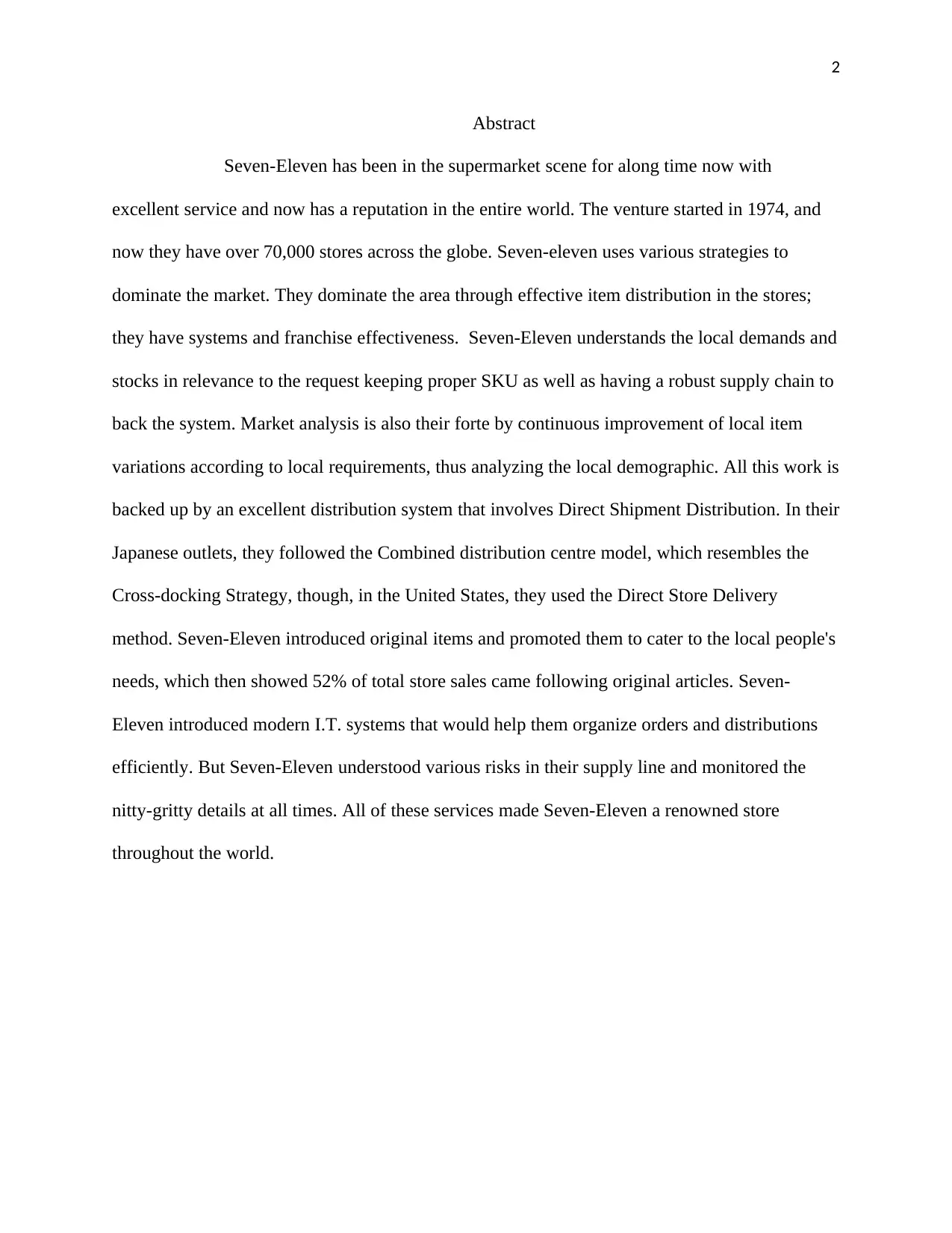
2
Abstract
Seven-Eleven has been in the supermarket scene for along time now with
excellent service and now has a reputation in the entire world. The venture started in 1974, and
now they have over 70,000 stores across the globe. Seven-eleven uses various strategies to
dominate the market. They dominate the area through effective item distribution in the stores;
they have systems and franchise effectiveness. Seven-Eleven understands the local demands and
stocks in relevance to the request keeping proper SKU as well as having a robust supply chain to
back the system. Market analysis is also their forte by continuous improvement of local item
variations according to local requirements, thus analyzing the local demographic. All this work is
backed up by an excellent distribution system that involves Direct Shipment Distribution. In their
Japanese outlets, they followed the Combined distribution centre model, which resembles the
Cross-docking Strategy, though, in the United States, they used the Direct Store Delivery
method. Seven-Eleven introduced original items and promoted them to cater to the local people's
needs, which then showed 52% of total store sales came following original articles. Seven-
Eleven introduced modern I.T. systems that would help them organize orders and distributions
efficiently. But Seven-Eleven understood various risks in their supply line and monitored the
nitty-gritty details at all times. All of these services made Seven-Eleven a renowned store
throughout the world.
Abstract
Seven-Eleven has been in the supermarket scene for along time now with
excellent service and now has a reputation in the entire world. The venture started in 1974, and
now they have over 70,000 stores across the globe. Seven-eleven uses various strategies to
dominate the market. They dominate the area through effective item distribution in the stores;
they have systems and franchise effectiveness. Seven-Eleven understands the local demands and
stocks in relevance to the request keeping proper SKU as well as having a robust supply chain to
back the system. Market analysis is also their forte by continuous improvement of local item
variations according to local requirements, thus analyzing the local demographic. All this work is
backed up by an excellent distribution system that involves Direct Shipment Distribution. In their
Japanese outlets, they followed the Combined distribution centre model, which resembles the
Cross-docking Strategy, though, in the United States, they used the Direct Store Delivery
method. Seven-Eleven introduced original items and promoted them to cater to the local people's
needs, which then showed 52% of total store sales came following original articles. Seven-
Eleven introduced modern I.T. systems that would help them organize orders and distributions
efficiently. But Seven-Eleven understood various risks in their supply line and monitored the
nitty-gritty details at all times. All of these services made Seven-Eleven a renowned store
throughout the world.
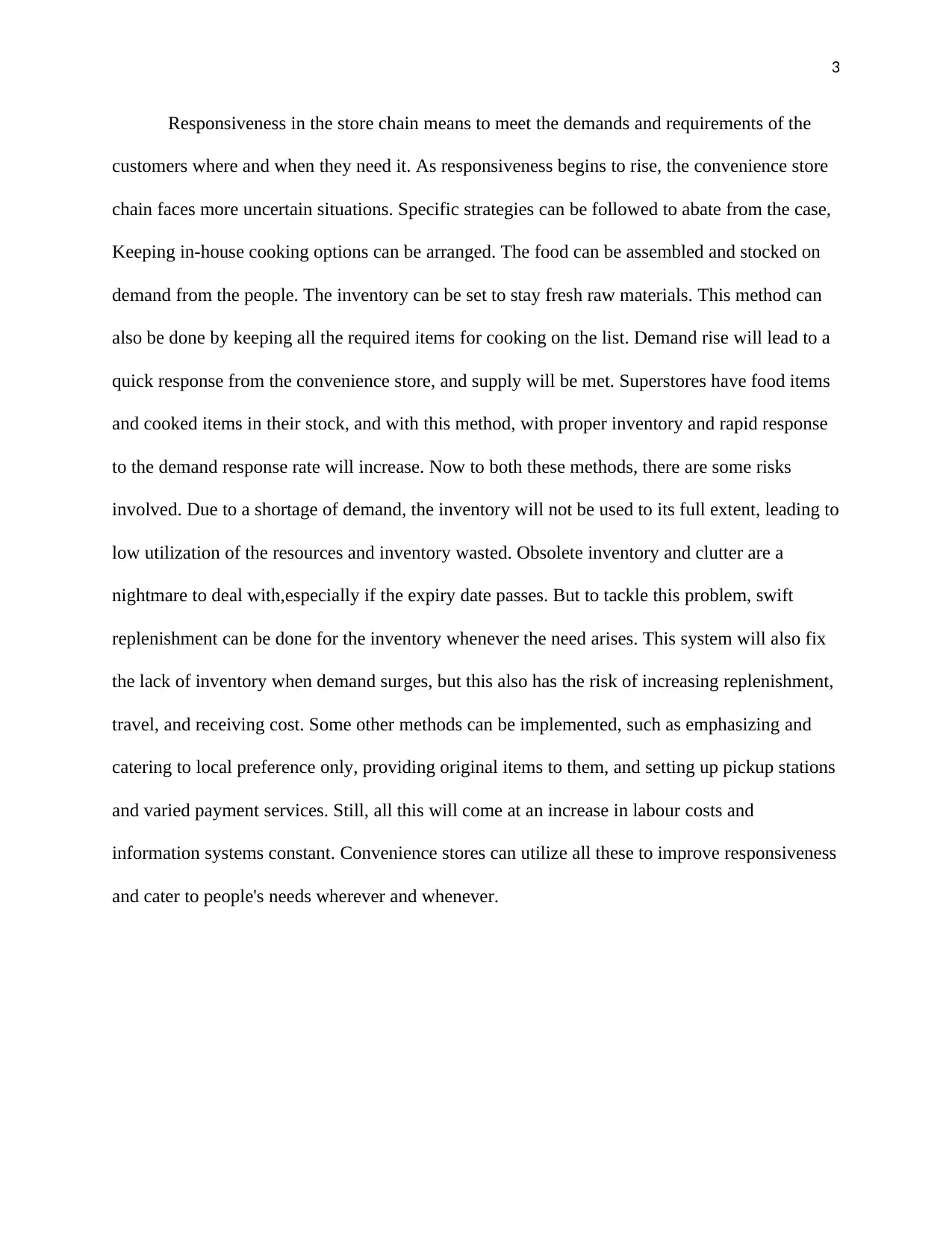
3
Responsiveness in the store chain means to meet the demands and requirements of the
customers where and when they need it. As responsiveness begins to rise, the convenience store
chain faces more uncertain situations. Specific strategies can be followed to abate from the case,
Keeping in-house cooking options can be arranged. The food can be assembled and stocked on
demand from the people. The inventory can be set to stay fresh raw materials. This method can
also be done by keeping all the required items for cooking on the list. Demand rise will lead to a
quick response from the convenience store, and supply will be met. Superstores have food items
and cooked items in their stock, and with this method, with proper inventory and rapid response
to the demand response rate will increase. Now to both these methods, there are some risks
involved. Due to a shortage of demand, the inventory will not be used to its full extent, leading to
low utilization of the resources and inventory wasted. Obsolete inventory and clutter are a
nightmare to deal with,especially if the expiry date passes. But to tackle this problem, swift
replenishment can be done for the inventory whenever the need arises. This system will also fix
the lack of inventory when demand surges, but this also has the risk of increasing replenishment,
travel, and receiving cost. Some other methods can be implemented, such as emphasizing and
catering to local preference only, providing original items to them, and setting up pickup stations
and varied payment services. Still, all this will come at an increase in labour costs and
information systems constant. Convenience stores can utilize all these to improve responsiveness
and cater to people's needs wherever and whenever.
Responsiveness in the store chain means to meet the demands and requirements of the
customers where and when they need it. As responsiveness begins to rise, the convenience store
chain faces more uncertain situations. Specific strategies can be followed to abate from the case,
Keeping in-house cooking options can be arranged. The food can be assembled and stocked on
demand from the people. The inventory can be set to stay fresh raw materials. This method can
also be done by keeping all the required items for cooking on the list. Demand rise will lead to a
quick response from the convenience store, and supply will be met. Superstores have food items
and cooked items in their stock, and with this method, with proper inventory and rapid response
to the demand response rate will increase. Now to both these methods, there are some risks
involved. Due to a shortage of demand, the inventory will not be used to its full extent, leading to
low utilization of the resources and inventory wasted. Obsolete inventory and clutter are a
nightmare to deal with,especially if the expiry date passes. But to tackle this problem, swift
replenishment can be done for the inventory whenever the need arises. This system will also fix
the lack of inventory when demand surges, but this also has the risk of increasing replenishment,
travel, and receiving cost. Some other methods can be implemented, such as emphasizing and
catering to local preference only, providing original items to them, and setting up pickup stations
and varied payment services. Still, all this will come at an increase in labour costs and
information systems constant. Convenience stores can utilize all these to improve responsiveness
and cater to people's needs wherever and whenever.
⊘ This is a preview!⊘
Do you want full access?
Subscribe today to unlock all pages.

Trusted by 1+ million students worldwide
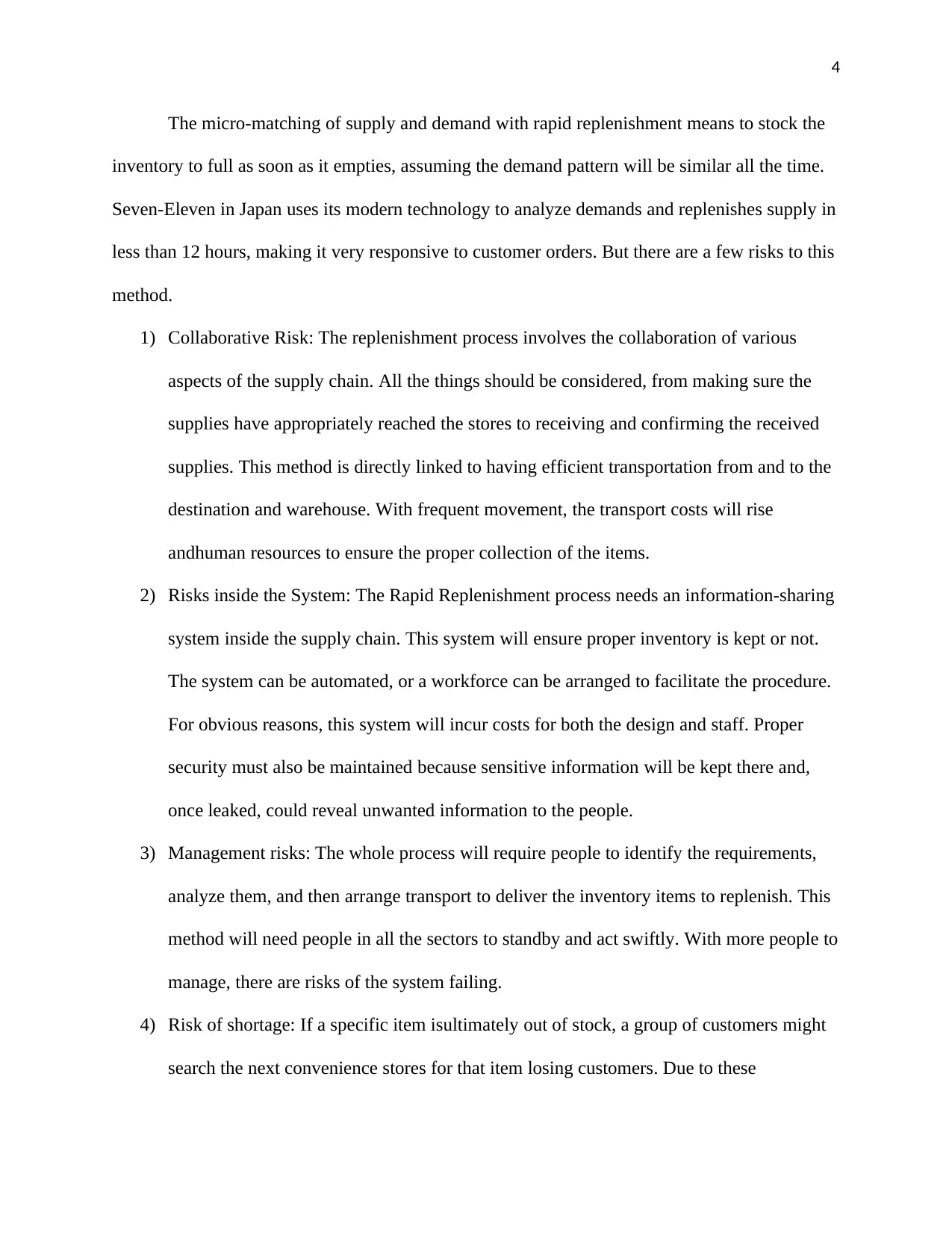
4
The micro-matching of supply and demand with rapid replenishment means to stock the
inventory to full as soon as it empties, assuming the demand pattern will be similar all the time.
Seven-Eleven in Japan uses its modern technology to analyze demands and replenishes supply in
less than 12 hours, making it very responsive to customer orders. But there are a few risks to this
method.
1) Collaborative Risk: The replenishment process involves the collaboration of various
aspects of the supply chain. All the things should be considered, from making sure the
supplies have appropriately reached the stores to receiving and confirming the received
supplies. This method is directly linked to having efficient transportation from and to the
destination and warehouse. With frequent movement, the transport costs will rise
andhuman resources to ensure the proper collection of the items.
2) Risks inside the System: The Rapid Replenishment process needs an information-sharing
system inside the supply chain. This system will ensure proper inventory is kept or not.
The system can be automated, or a workforce can be arranged to facilitate the procedure.
For obvious reasons, this system will incur costs for both the design and staff. Proper
security must also be maintained because sensitive information will be kept there and,
once leaked, could reveal unwanted information to the people.
3) Management risks: The whole process will require people to identify the requirements,
analyze them, and then arrange transport to deliver the inventory items to replenish. This
method will need people in all the sectors to standby and act swiftly. With more people to
manage, there are risks of the system failing.
4) Risk of shortage: If a specific item isultimately out of stock, a group of customers might
search the next convenience stores for that item losing customers. Due to these
The micro-matching of supply and demand with rapid replenishment means to stock the
inventory to full as soon as it empties, assuming the demand pattern will be similar all the time.
Seven-Eleven in Japan uses its modern technology to analyze demands and replenishes supply in
less than 12 hours, making it very responsive to customer orders. But there are a few risks to this
method.
1) Collaborative Risk: The replenishment process involves the collaboration of various
aspects of the supply chain. All the things should be considered, from making sure the
supplies have appropriately reached the stores to receiving and confirming the received
supplies. This method is directly linked to having efficient transportation from and to the
destination and warehouse. With frequent movement, the transport costs will rise
andhuman resources to ensure the proper collection of the items.
2) Risks inside the System: The Rapid Replenishment process needs an information-sharing
system inside the supply chain. This system will ensure proper inventory is kept or not.
The system can be automated, or a workforce can be arranged to facilitate the procedure.
For obvious reasons, this system will incur costs for both the design and staff. Proper
security must also be maintained because sensitive information will be kept there and,
once leaked, could reveal unwanted information to the people.
3) Management risks: The whole process will require people to identify the requirements,
analyze them, and then arrange transport to deliver the inventory items to replenish. This
method will need people in all the sectors to standby and act swiftly. With more people to
manage, there are risks of the system failing.
4) Risk of shortage: If a specific item isultimately out of stock, a group of customers might
search the next convenience stores for that item losing customers. Due to these
Paraphrase This Document
Need a fresh take? Get an instant paraphrase of this document with our AI Paraphraser
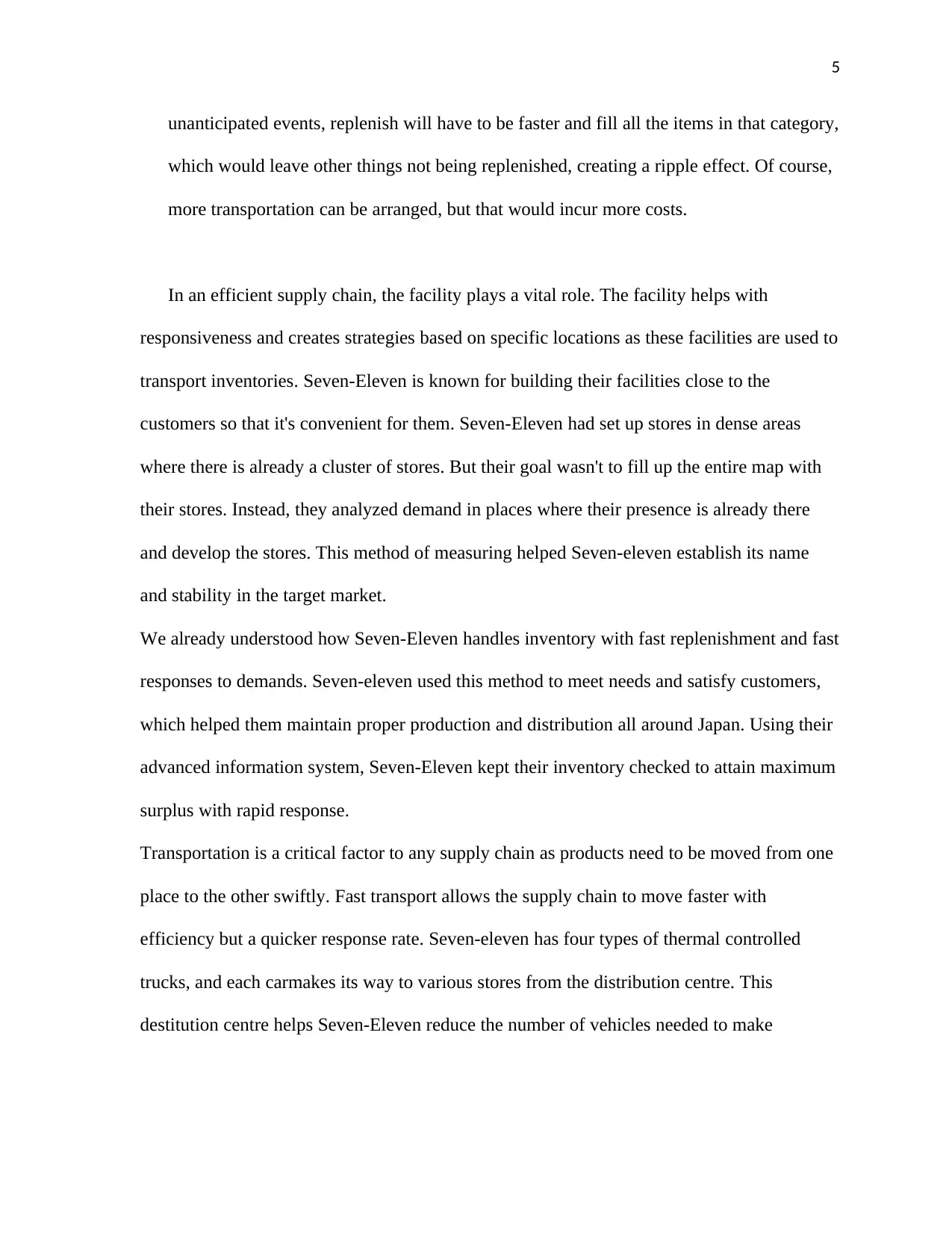
5
unanticipated events, replenish will have to be faster and fill all the items in that category,
which would leave other things not being replenished, creating a ripple effect. Of course,
more transportation can be arranged, but that would incur more costs.
In an efficient supply chain, the facility plays a vital role. The facility helps with
responsiveness and creates strategies based on specific locations as these facilities are used to
transport inventories. Seven-Eleven is known for building their facilities close to the
customers so that it's convenient for them. Seven-Eleven had set up stores in dense areas
where there is already a cluster of stores. But their goal wasn't to fill up the entire map with
their stores. Instead, they analyzed demand in places where their presence is already there
and develop the stores. This method of measuring helped Seven-eleven establish its name
and stability in the target market.
We already understood how Seven-Eleven handles inventory with fast replenishment and fast
responses to demands. Seven-eleven used this method to meet needs and satisfy customers,
which helped them maintain proper production and distribution all around Japan. Using their
advanced information system, Seven-Eleven kept their inventory checked to attain maximum
surplus with rapid response.
Transportation is a critical factor to any supply chain as products need to be moved from one
place to the other swiftly. Fast transport allows the supply chain to move faster with
efficiency but a quicker response rate. Seven-eleven has four types of thermal controlled
trucks, and each carmakes its way to various stores from the distribution centre. This
destitution centre helps Seven-Eleven reduce the number of vehicles needed to make
unanticipated events, replenish will have to be faster and fill all the items in that category,
which would leave other things not being replenished, creating a ripple effect. Of course,
more transportation can be arranged, but that would incur more costs.
In an efficient supply chain, the facility plays a vital role. The facility helps with
responsiveness and creates strategies based on specific locations as these facilities are used to
transport inventories. Seven-Eleven is known for building their facilities close to the
customers so that it's convenient for them. Seven-Eleven had set up stores in dense areas
where there is already a cluster of stores. But their goal wasn't to fill up the entire map with
their stores. Instead, they analyzed demand in places where their presence is already there
and develop the stores. This method of measuring helped Seven-eleven establish its name
and stability in the target market.
We already understood how Seven-Eleven handles inventory with fast replenishment and fast
responses to demands. Seven-eleven used this method to meet needs and satisfy customers,
which helped them maintain proper production and distribution all around Japan. Using their
advanced information system, Seven-Eleven kept their inventory checked to attain maximum
surplus with rapid response.
Transportation is a critical factor to any supply chain as products need to be moved from one
place to the other swiftly. Fast transport allows the supply chain to move faster with
efficiency but a quicker response rate. Seven-eleven has four types of thermal controlled
trucks, and each carmakes its way to various stores from the distribution centre. This
destitution centre helps Seven-Eleven reduce the number of vehicles needed to make
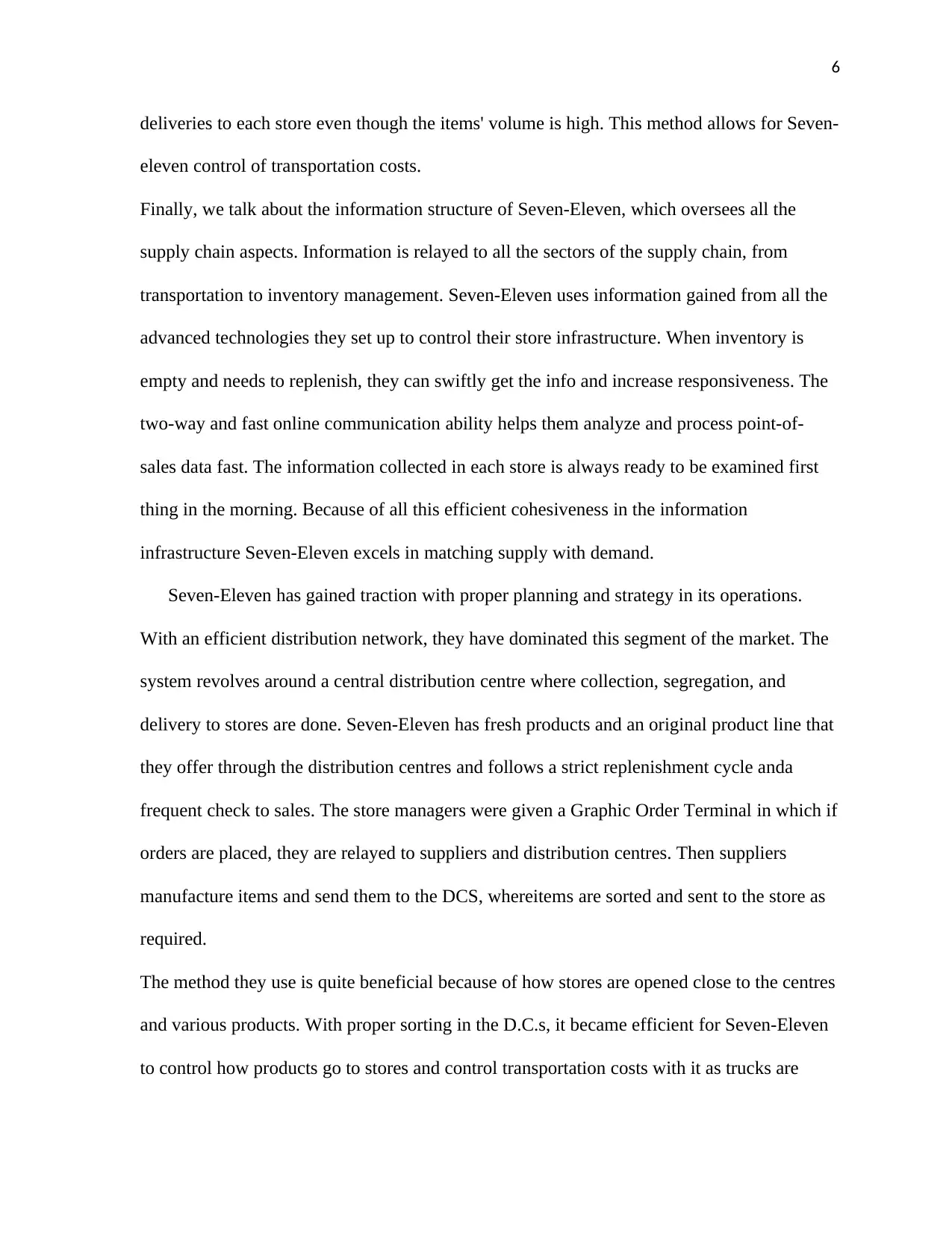
6
deliveries to each store even though the items' volume is high. This method allows for Seven-
eleven control of transportation costs.
Finally, we talk about the information structure of Seven-Eleven, which oversees all the
supply chain aspects. Information is relayed to all the sectors of the supply chain, from
transportation to inventory management. Seven-Eleven uses information gained from all the
advanced technologies they set up to control their store infrastructure. When inventory is
empty and needs to replenish, they can swiftly get the info and increase responsiveness. The
two-way and fast online communication ability helps them analyze and process point-of-
sales data fast. The information collected in each store is always ready to be examined first
thing in the morning. Because of all this efficient cohesiveness in the information
infrastructure Seven-Eleven excels in matching supply with demand.
Seven-Eleven has gained traction with proper planning and strategy in its operations.
With an efficient distribution network, they have dominated this segment of the market. The
system revolves around a central distribution centre where collection, segregation, and
delivery to stores are done. Seven-Eleven has fresh products and an original product line that
they offer through the distribution centres and follows a strict replenishment cycle anda
frequent check to sales. The store managers were given a Graphic Order Terminal in which if
orders are placed, they are relayed to suppliers and distribution centres. Then suppliers
manufacture items and send them to the DCS, whereitems are sorted and sent to the store as
required.
The method they use is quite beneficial because of how stores are opened close to the centres
and various products. With proper sorting in the D.C.s, it became efficient for Seven-Eleven
to control how products go to stores and control transportation costs with it as trucks are
deliveries to each store even though the items' volume is high. This method allows for Seven-
eleven control of transportation costs.
Finally, we talk about the information structure of Seven-Eleven, which oversees all the
supply chain aspects. Information is relayed to all the sectors of the supply chain, from
transportation to inventory management. Seven-Eleven uses information gained from all the
advanced technologies they set up to control their store infrastructure. When inventory is
empty and needs to replenish, they can swiftly get the info and increase responsiveness. The
two-way and fast online communication ability helps them analyze and process point-of-
sales data fast. The information collected in each store is always ready to be examined first
thing in the morning. Because of all this efficient cohesiveness in the information
infrastructure Seven-Eleven excels in matching supply with demand.
Seven-Eleven has gained traction with proper planning and strategy in its operations.
With an efficient distribution network, they have dominated this segment of the market. The
system revolves around a central distribution centre where collection, segregation, and
delivery to stores are done. Seven-Eleven has fresh products and an original product line that
they offer through the distribution centres and follows a strict replenishment cycle anda
frequent check to sales. The store managers were given a Graphic Order Terminal in which if
orders are placed, they are relayed to suppliers and distribution centres. Then suppliers
manufacture items and send them to the DCS, whereitems are sorted and sent to the store as
required.
The method they use is quite beneficial because of how stores are opened close to the centres
and various products. With proper sorting in the D.C.s, it became efficient for Seven-Eleven
to control how products go to stores and control transportation costs with it as trucks are
⊘ This is a preview!⊘
Do you want full access?
Subscribe today to unlock all pages.

Trusted by 1+ million students worldwide
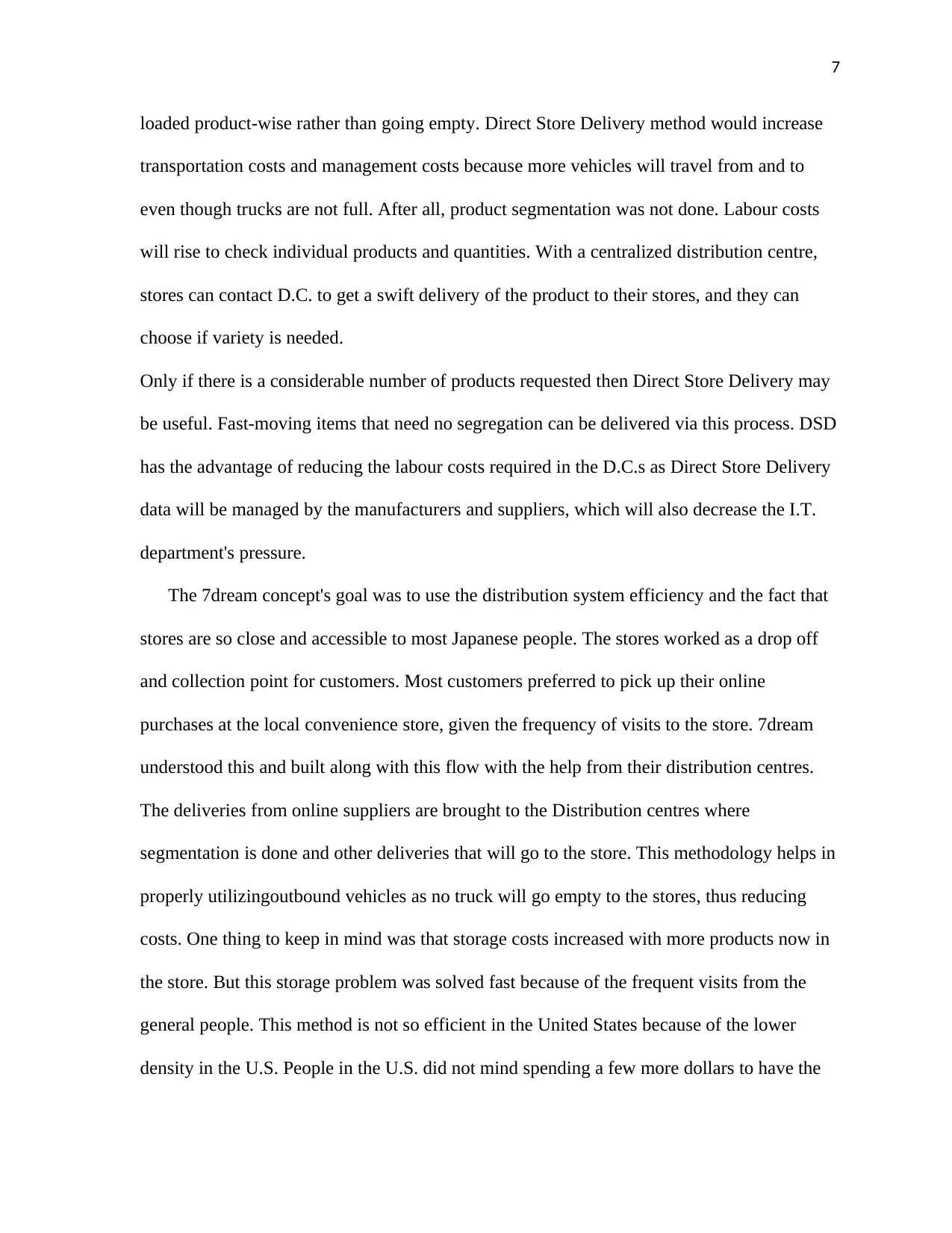
7
loaded product-wise rather than going empty. Direct Store Delivery method would increase
transportation costs and management costs because more vehicles will travel from and to
even though trucks are not full. After all, product segmentation was not done. Labour costs
will rise to check individual products and quantities. With a centralized distribution centre,
stores can contact D.C. to get a swift delivery of the product to their stores, and they can
choose if variety is needed.
Only if there is a considerable number of products requested then Direct Store Delivery may
be useful. Fast-moving items that need no segregation can be delivered via this process. DSD
has the advantage of reducing the labour costs required in the D.C.s as Direct Store Delivery
data will be managed by the manufacturers and suppliers, which will also decrease the I.T.
department's pressure.
The 7dream concept's goal was to use the distribution system efficiency and the fact that
stores are so close and accessible to most Japanese people. The stores worked as a drop off
and collection point for customers. Most customers preferred to pick up their online
purchases at the local convenience store, given the frequency of visits to the store. 7dream
understood this and built along with this flow with the help from their distribution centres.
The deliveries from online suppliers are brought to the Distribution centres where
segmentation is done and other deliveries that will go to the store. This methodology helps in
properly utilizingoutbound vehicles as no truck will go empty to the stores, thus reducing
costs. One thing to keep in mind was that storage costs increased with more products now in
the store. But this storage problem was solved fast because of the frequent visits from the
general people. This method is not so efficient in the United States because of the lower
density in the U.S. People in the U.S. did not mind spending a few more dollars to have the
loaded product-wise rather than going empty. Direct Store Delivery method would increase
transportation costs and management costs because more vehicles will travel from and to
even though trucks are not full. After all, product segmentation was not done. Labour costs
will rise to check individual products and quantities. With a centralized distribution centre,
stores can contact D.C. to get a swift delivery of the product to their stores, and they can
choose if variety is needed.
Only if there is a considerable number of products requested then Direct Store Delivery may
be useful. Fast-moving items that need no segregation can be delivered via this process. DSD
has the advantage of reducing the labour costs required in the D.C.s as Direct Store Delivery
data will be managed by the manufacturers and suppliers, which will also decrease the I.T.
department's pressure.
The 7dream concept's goal was to use the distribution system efficiency and the fact that
stores are so close and accessible to most Japanese people. The stores worked as a drop off
and collection point for customers. Most customers preferred to pick up their online
purchases at the local convenience store, given the frequency of visits to the store. 7dream
understood this and built along with this flow with the help from their distribution centres.
The deliveries from online suppliers are brought to the Distribution centres where
segmentation is done and other deliveries that will go to the store. This methodology helps in
properly utilizingoutbound vehicles as no truck will go empty to the stores, thus reducing
costs. One thing to keep in mind was that storage costs increased with more products now in
the store. But this storage problem was solved fast because of the frequent visits from the
general people. This method is not so efficient in the United States because of the lower
density in the U.S. People in the U.S. did not mind spending a few more dollars to have the
Paraphrase This Document
Need a fresh take? Get an instant paraphrase of this document with our AI Paraphraser
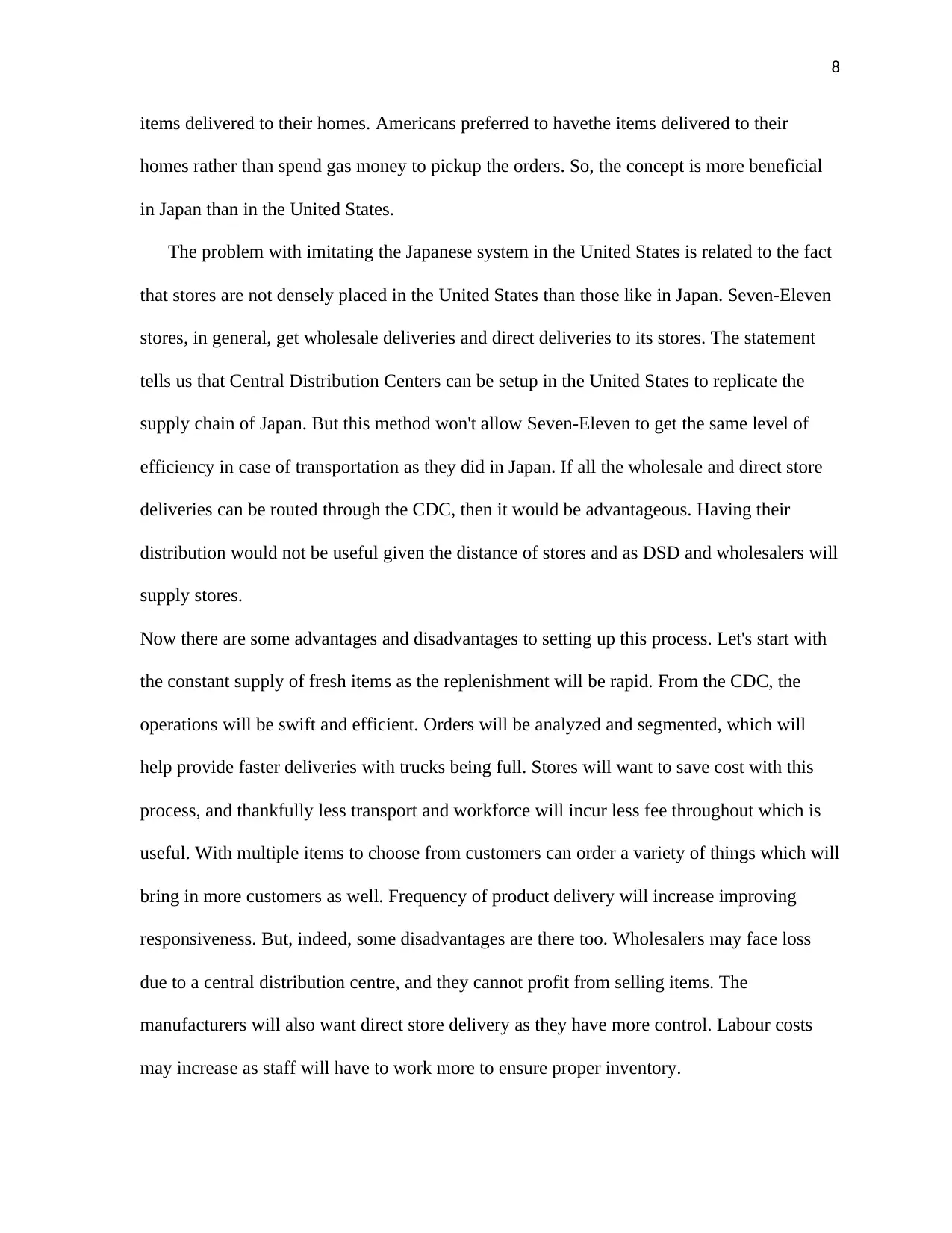
8
items delivered to their homes. Americans preferred to havethe items delivered to their
homes rather than spend gas money to pickup the orders. So, the concept is more beneficial
in Japan than in the United States.
The problem with imitating the Japanese system in the United States is related to the fact
that stores are not densely placed in the United States than those like in Japan. Seven-Eleven
stores, in general, get wholesale deliveries and direct deliveries to its stores. The statement
tells us that Central Distribution Centers can be setup in the United States to replicate the
supply chain of Japan. But this method won't allow Seven-Eleven to get the same level of
efficiency in case of transportation as they did in Japan. If all the wholesale and direct store
deliveries can be routed through the CDC, then it would be advantageous. Having their
distribution would not be useful given the distance of stores and as DSD and wholesalers will
supply stores.
Now there are some advantages and disadvantages to setting up this process. Let's start with
the constant supply of fresh items as the replenishment will be rapid. From the CDC, the
operations will be swift and efficient. Orders will be analyzed and segmented, which will
help provide faster deliveries with trucks being full. Stores will want to save cost with this
process, and thankfully less transport and workforce will incur less fee throughout which is
useful. With multiple items to choose from customers can order a variety of things which will
bring in more customers as well. Frequency of product delivery will increase improving
responsiveness. But, indeed, some disadvantages are there too. Wholesalers may face loss
due to a central distribution centre, and they cannot profit from selling items. The
manufacturers will also want direct store delivery as they have more control. Labour costs
may increase as staff will have to work more to ensure proper inventory.
items delivered to their homes. Americans preferred to havethe items delivered to their
homes rather than spend gas money to pickup the orders. So, the concept is more beneficial
in Japan than in the United States.
The problem with imitating the Japanese system in the United States is related to the fact
that stores are not densely placed in the United States than those like in Japan. Seven-Eleven
stores, in general, get wholesale deliveries and direct deliveries to its stores. The statement
tells us that Central Distribution Centers can be setup in the United States to replicate the
supply chain of Japan. But this method won't allow Seven-Eleven to get the same level of
efficiency in case of transportation as they did in Japan. If all the wholesale and direct store
deliveries can be routed through the CDC, then it would be advantageous. Having their
distribution would not be useful given the distance of stores and as DSD and wholesalers will
supply stores.
Now there are some advantages and disadvantages to setting up this process. Let's start with
the constant supply of fresh items as the replenishment will be rapid. From the CDC, the
operations will be swift and efficient. Orders will be analyzed and segmented, which will
help provide faster deliveries with trucks being full. Stores will want to save cost with this
process, and thankfully less transport and workforce will incur less fee throughout which is
useful. With multiple items to choose from customers can order a variety of things which will
bring in more customers as well. Frequency of product delivery will increase improving
responsiveness. But, indeed, some disadvantages are there too. Wholesalers may face loss
due to a central distribution centre, and they cannot profit from selling items. The
manufacturers will also want direct store delivery as they have more control. Labour costs
may increase as staff will have to work more to ensure proper inventory.
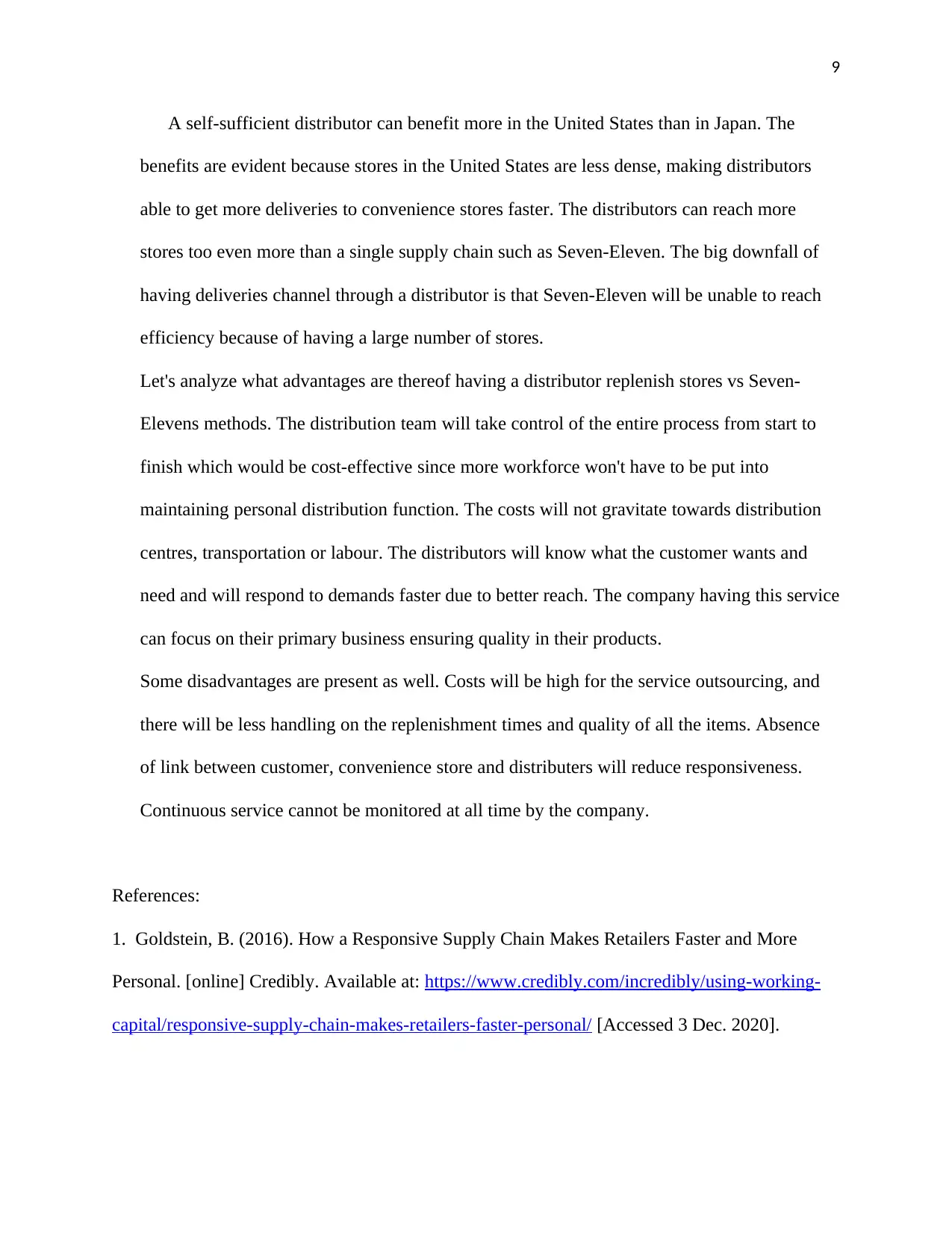
9
A self-sufficient distributor can benefit more in the United States than in Japan. The
benefits are evident because stores in the United States are less dense, making distributors
able to get more deliveries to convenience stores faster. The distributors can reach more
stores too even more than a single supply chain such as Seven-Eleven. The big downfall of
having deliveries channel through a distributor is that Seven-Eleven will be unable to reach
efficiency because of having a large number of stores.
Let's analyze what advantages are thereof having a distributor replenish stores vs Seven-
Elevens methods. The distribution team will take control of the entire process from start to
finish which would be cost-effective since more workforce won't have to be put into
maintaining personal distribution function. The costs will not gravitate towards distribution
centres, transportation or labour. The distributors will know what the customer wants and
need and will respond to demands faster due to better reach. The company having this service
can focus on their primary business ensuring quality in their products.
Some disadvantages are present as well. Costs will be high for the service outsourcing, and
there will be less handling on the replenishment times and quality of all the items. Absence
of link between customer, convenience store and distributers will reduce responsiveness.
Continuous service cannot be monitored at all time by the company.
References:
1. Goldstein, B. (2016). How a Responsive Supply Chain Makes Retailers Faster and More
Personal. [online] Credibly. Available at: https://www.credibly.com/incredibly/using-working-
capital/responsive-supply-chain-makes-retailers-faster-personal/ [Accessed 3 Dec. 2020].
A self-sufficient distributor can benefit more in the United States than in Japan. The
benefits are evident because stores in the United States are less dense, making distributors
able to get more deliveries to convenience stores faster. The distributors can reach more
stores too even more than a single supply chain such as Seven-Eleven. The big downfall of
having deliveries channel through a distributor is that Seven-Eleven will be unable to reach
efficiency because of having a large number of stores.
Let's analyze what advantages are thereof having a distributor replenish stores vs Seven-
Elevens methods. The distribution team will take control of the entire process from start to
finish which would be cost-effective since more workforce won't have to be put into
maintaining personal distribution function. The costs will not gravitate towards distribution
centres, transportation or labour. The distributors will know what the customer wants and
need and will respond to demands faster due to better reach. The company having this service
can focus on their primary business ensuring quality in their products.
Some disadvantages are present as well. Costs will be high for the service outsourcing, and
there will be less handling on the replenishment times and quality of all the items. Absence
of link between customer, convenience store and distributers will reduce responsiveness.
Continuous service cannot be monitored at all time by the company.
References:
1. Goldstein, B. (2016). How a Responsive Supply Chain Makes Retailers Faster and More
Personal. [online] Credibly. Available at: https://www.credibly.com/incredibly/using-working-
capital/responsive-supply-chain-makes-retailers-faster-personal/ [Accessed 3 Dec. 2020].
⊘ This is a preview!⊘
Do you want full access?
Subscribe today to unlock all pages.

Trusted by 1+ million students worldwide
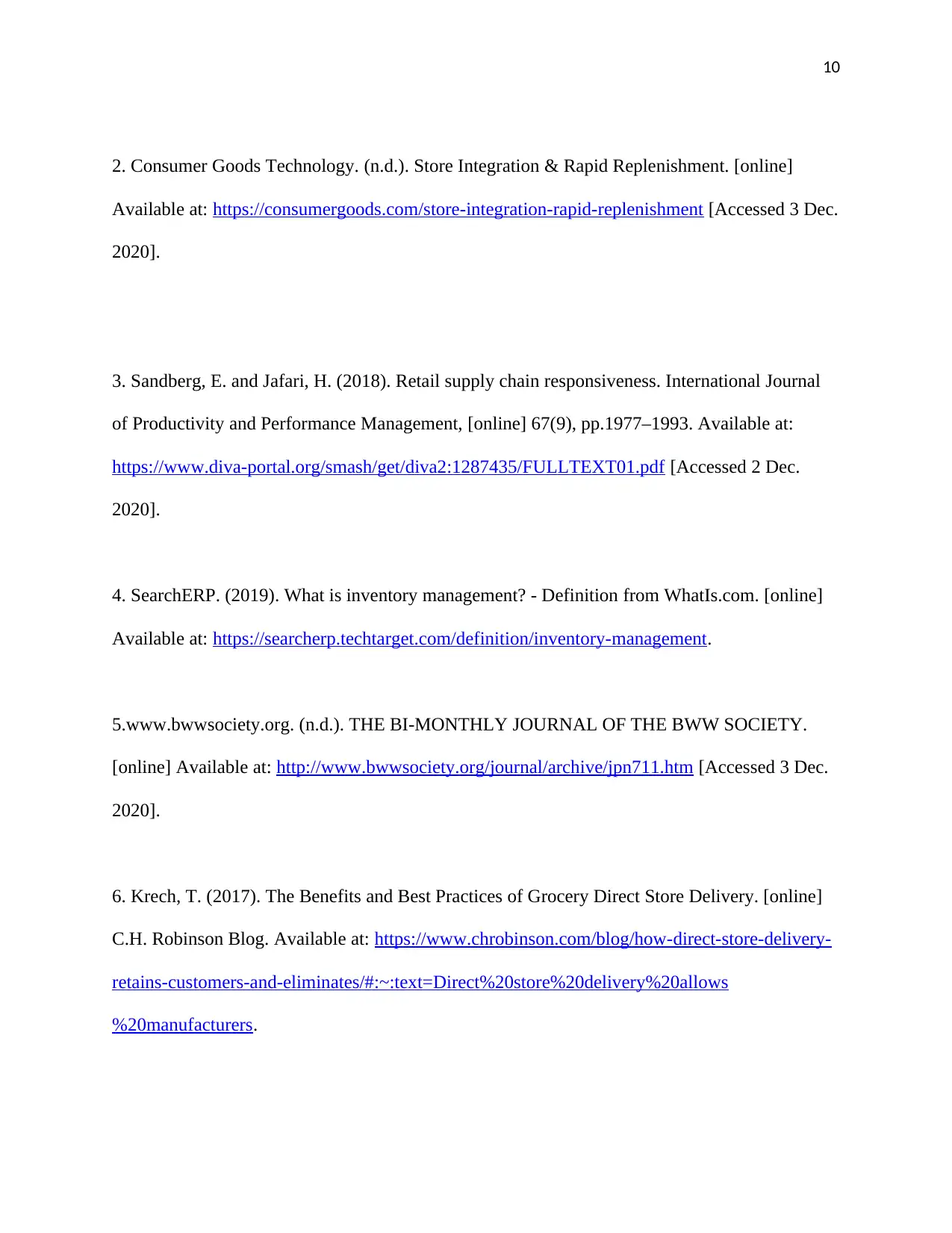
10
2. Consumer Goods Technology. (n.d.). Store Integration & Rapid Replenishment. [online]
Available at: https://consumergoods.com/store-integration-rapid-replenishment [Accessed 3 Dec.
2020].
3. Sandberg, E. and Jafari, H. (2018). Retail supply chain responsiveness. International Journal
of Productivity and Performance Management, [online] 67(9), pp.1977–1993. Available at:
https://www.diva-portal.org/smash/get/diva2:1287435/FULLTEXT01.pdf [Accessed 2 Dec.
2020].
4. SearchERP. (2019). What is inventory management? - Definition from WhatIs.com. [online]
Available at: https://searcherp.techtarget.com/definition/inventory-management.
5.www.bwwsociety.org. (n.d.). THE BI-MONTHLY JOURNAL OF THE BWW SOCIETY.
[online] Available at: http://www.bwwsociety.org/journal/archive/jpn711.htm [Accessed 3 Dec.
2020].
6. Krech, T. (2017). The Benefits and Best Practices of Grocery Direct Store Delivery. [online]
C.H. Robinson Blog. Available at: https://www.chrobinson.com/blog/how-direct-store-delivery-
retains-customers-and-eliminates/#:~:text=Direct%20store%20delivery%20allows
%20manufacturers.
2. Consumer Goods Technology. (n.d.). Store Integration & Rapid Replenishment. [online]
Available at: https://consumergoods.com/store-integration-rapid-replenishment [Accessed 3 Dec.
2020].
3. Sandberg, E. and Jafari, H. (2018). Retail supply chain responsiveness. International Journal
of Productivity and Performance Management, [online] 67(9), pp.1977–1993. Available at:
https://www.diva-portal.org/smash/get/diva2:1287435/FULLTEXT01.pdf [Accessed 2 Dec.
2020].
4. SearchERP. (2019). What is inventory management? - Definition from WhatIs.com. [online]
Available at: https://searcherp.techtarget.com/definition/inventory-management.
5.www.bwwsociety.org. (n.d.). THE BI-MONTHLY JOURNAL OF THE BWW SOCIETY.
[online] Available at: http://www.bwwsociety.org/journal/archive/jpn711.htm [Accessed 3 Dec.
2020].
6. Krech, T. (2017). The Benefits and Best Practices of Grocery Direct Store Delivery. [online]
C.H. Robinson Blog. Available at: https://www.chrobinson.com/blog/how-direct-store-delivery-
retains-customers-and-eliminates/#:~:text=Direct%20store%20delivery%20allows
%20manufacturers.
Paraphrase This Document
Need a fresh take? Get an instant paraphrase of this document with our AI Paraphraser
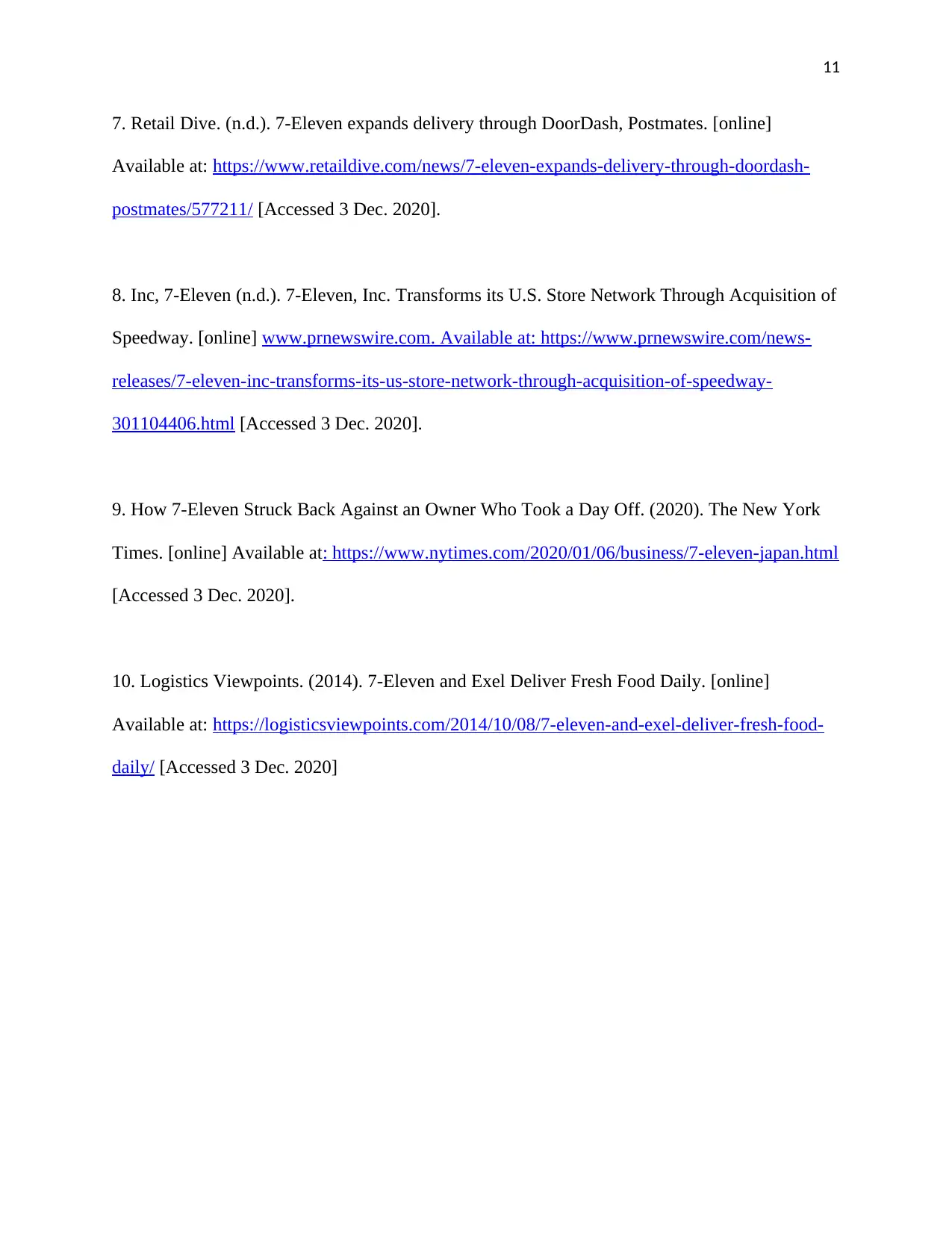
11
7. Retail Dive. (n.d.). 7-Eleven expands delivery through DoorDash, Postmates. [online]
Available at: https://www.retaildive.com/news/7-eleven-expands-delivery-through-doordash-
postmates/577211/ [Accessed 3 Dec. 2020].
8. Inc, 7-Eleven (n.d.). 7-Eleven, Inc. Transforms its U.S. Store Network Through Acquisition of
Speedway. [online] www.prnewswire.com. Available at: https://www.prnewswire.com/news-
releases/7-eleven-inc-transforms-its-us-store-network-through-acquisition-of-speedway-
301104406.html [Accessed 3 Dec. 2020].
9. How 7-Eleven Struck Back Against an Owner Who Took a Day Off. (2020). The New York
Times. [online] Available at: https://www.nytimes.com/2020/01/06/business/7-eleven-japan.html
[Accessed 3 Dec. 2020].
10. Logistics Viewpoints. (2014). 7-Eleven and Exel Deliver Fresh Food Daily. [online]
Available at: https://logisticsviewpoints.com/2014/10/08/7-eleven-and-exel-deliver-fresh-food-
daily/ [Accessed 3 Dec. 2020]
7. Retail Dive. (n.d.). 7-Eleven expands delivery through DoorDash, Postmates. [online]
Available at: https://www.retaildive.com/news/7-eleven-expands-delivery-through-doordash-
postmates/577211/ [Accessed 3 Dec. 2020].
8. Inc, 7-Eleven (n.d.). 7-Eleven, Inc. Transforms its U.S. Store Network Through Acquisition of
Speedway. [online] www.prnewswire.com. Available at: https://www.prnewswire.com/news-
releases/7-eleven-inc-transforms-its-us-store-network-through-acquisition-of-speedway-
301104406.html [Accessed 3 Dec. 2020].
9. How 7-Eleven Struck Back Against an Owner Who Took a Day Off. (2020). The New York
Times. [online] Available at: https://www.nytimes.com/2020/01/06/business/7-eleven-japan.html
[Accessed 3 Dec. 2020].
10. Logistics Viewpoints. (2014). 7-Eleven and Exel Deliver Fresh Food Daily. [online]
Available at: https://logisticsviewpoints.com/2014/10/08/7-eleven-and-exel-deliver-fresh-food-
daily/ [Accessed 3 Dec. 2020]
1 out of 11
Related Documents
Your All-in-One AI-Powered Toolkit for Academic Success.
+13062052269
info@desklib.com
Available 24*7 on WhatsApp / Email
![[object Object]](/_next/static/media/star-bottom.7253800d.svg)
Unlock your academic potential
Copyright © 2020–2025 A2Z Services. All Rights Reserved. Developed and managed by ZUCOL.





